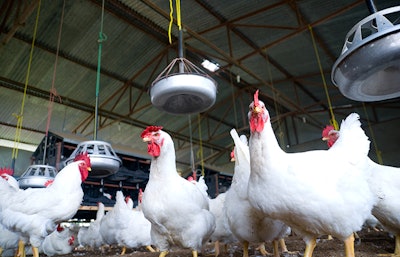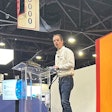
Machine vision can offer poultry farmers a way to improve productivity while still maintaining and monitoring poultry health, behaviors and welfare.
During the Poultry Tech Webinar Series, Lilong Chai, Ph.D., assistant professor and poultry engineering specialist, University of Georgia discussed how machine vision can be used to detect broiler floor distribution patterns, behaviors and welfare patterns.
In commercial bedding floor poultry houses, bird density and distribution pattern are critical factors for evaluating production management and animal health/welfare. Currently, daily routine inspection of broiler flock distribution in commercial grow-out houses is done manually, which is labor intensive and time consuming.
Chai’s research lab is working on developing machine vision technology that can automatically detect and monitor bird welfare, behaviors and health in drinking, feeding and resting activity zones within a poultry house.
How it works
The lab began by testing the use of machine vision to quantify the behavior patterns of 20 birds in a pen. With machine vision, the researchers helped the technology learn how to automatically detect and reconstruct partial images to correctly identify individual birds and monitor their activity.
“Most importantly, we found that the birds that stayed closest to feeders and drinkers were the ones with leg issues,” Chai said. This is because “the birds with leg issues are less mobile.”
Because of this, the machine vision system is designed to measure how long each bird spends in the feeding zone, the resting zone and the drinking zone, helping to automatically analyze welfare indicators.
However, a typical poultry house contains much more than 20 birds. Chai’s team studied a larger house that was divided into 12 quadrants with 12 birds in each. Although the machine vision image processing was slower than anticipated, the real time results still showed that individual birds with leg issues remained much closer to feed and drink areas than their healthy counterparts.
The research, which can be applied to both broilers and cage-free layers, provides the basis for developing a real-time evaluation tool to detect broiler chicken floor distribution patterns, behaviors and welfare indicators in commercial production facilities.
In larger commercial houses, the machine vision approach may be combined with robotic systems to scan the entire layout with only one camera, Chai noted.
“Machine vision is affected by many factors, including dust,” he cautioned, adding that the model will need to be adjusted between house to house.
What’s coming next
For more on the technologies set to advance the poultry industry, join industry-changing innovators, researchers, entrepreneurs, technology experts, investors and leading poultry producers at the Poultry Tech Webinar Series, scheduled for November 2, 4, 10, 11, 17, 30 and December 2.
During the webinar series, industry experts will preview what’s coming next – from prospective solutions to developing technology – for the poultry industry.
This webinar series is proudly sponsored by: Arm & Hammer, Aviagen, Baader, Boehringer Ingelheim, Cargill, Ceva, Chore-Time, Cobb, Evonik, Marel, Phibro Animal Health, Staubli and Zoetis.
Visit our website for more details on the webinar series, topics and speakers.
Register for free today and join us for a glimpse at the future of the poultry industry.



















